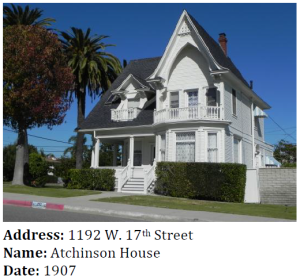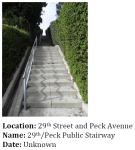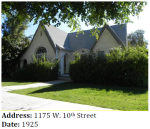By David J. Barboza

This Queen Anne / Carpenter Gothic house was built by the operator of the first harbor ferry service in San Pedro.
We’ve recently had the pleasure of releasing three new reports of SurveyLA findings for Los Angeles’ harbor communities: San Pedro, Harbor Gateway and Wilmington/Harbor City. The reports and their appendices are a great way to learn about the history and architecture of these neighborhoods, so hopefully you get a chance to check them out. If you think there is something we neglected to cover in the reports please let us know. You’ll find a quick overview of all three reports the latest newsletter from the Office of Historic Resources. In this post, I’ll be taking a look at the findings for San Pedro.
Before delving into individual historic places and districts, SurveyLA reports always start off with a historical overview of the neighborhood to help put the findings in context. From rancho origins, San Pedro was platted (divided into urban-scale lots) in 1882, at the beginning of the population boom of the 1880s and just one year after the Southern Pacific created the first inter-regional railroad connection to Los Angeles. San Pedro incorporated as a city in 1888. Major economic drivers in the area have included the military reservation (re-named Fort MacArthur in 1914) and the Port of Los Angeles. San Pedro was consolidated into the City of Los Angeles in 1909, the same year the Port was completed. San Pedro has a wide range of land uses and property types including detached houses, bungalow courts, apartment buildings, streetcar-era commercial structures, automobile oriented commercial buildings, industrial properties, institutional development and several parks. George Huntington Peck, Jr., one of San Pedro’s pioneering developers, made major land donations to the City of Los Angeles in the 1920s and 30s that form the basis of four of the neighborhood’s parks, including the one that bears his name. The first half of the 20th century saw waves of immigration that increased the area’s diversity. Some of the larger groups were Italians, Yugoslavians, Serb-Croatians, Scandanavians, Greeks, and Japanese. During World War II the population boomed yet again as the massive need for shipbuilding labor attracted many people. After the war, automobile-oriented development increased to the west of the historical core area along Gaffey St. and Pacific Ave. near the east waterfront.
As for the survey findings, I’ve picked out some of my favorites and shared them below. You can click on an image to enlarge it and switch to slideshow format. Enjoy!
- This Victorian Vernacular Cottage was built in the “pre-consolidation” era, before the City of San Pedro was incorporated into the City of Los Angeles.
- Buildings like this Spanish Colonial Revival apartment house played a critical role in housing the often seasonal workforce at the Port.
- Hilly topography and the need to quickly access streetcar and bus lines made public stairways like this important in some early residential areas.
- A rare intact example of an auto showroom from the 1930s.
- This Art Deco style clubhouse is associated with the Yugoslavian/Croatian community in San Pedro.
- This park dates back to 1889, the year after San Pedro incorporated as a city.
- A side-gabled Craftsman with a large gable dormer.
- This Tudor style house achieves a storybook effect through its rolled eaves, which allude to the look of thatched roofs in medieval Europe.








